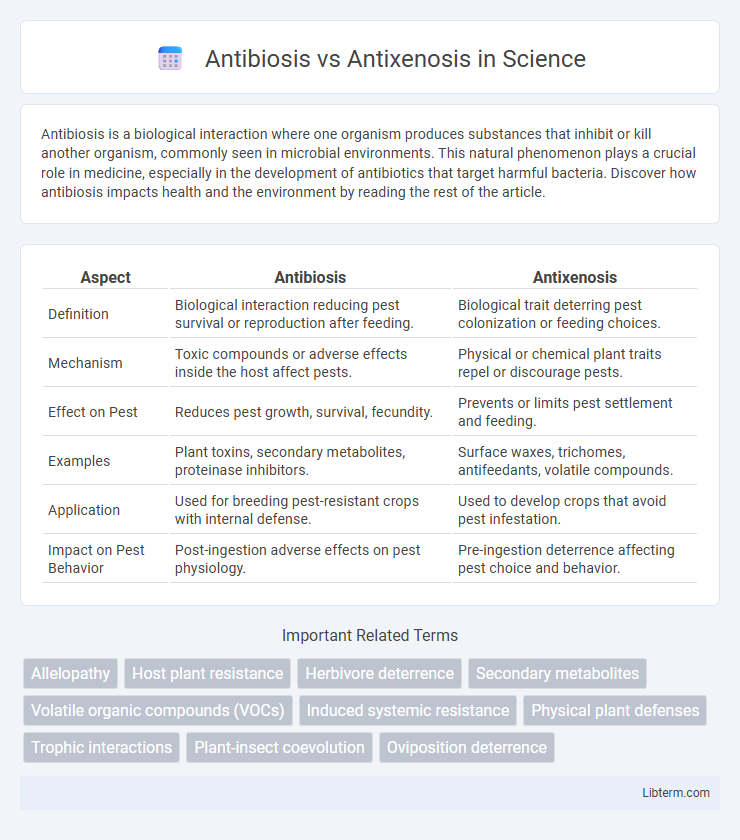Antibiosis is a biological interaction where one organism produces substances that inhibit or kill another organism, commonly seen in microbial environments. This natural phenomenon plays a crucial role in medicine, especially in the development of antibiotics that target harmful bacteria. Discover how antibiosis impacts health and the environment by reading the rest of the article.
Table of Comparison
| Aspect | Antibiosis | Antixenosis |
|---|---|---|
| Definition | Biological interaction reducing pest survival or reproduction after feeding. | Biological trait deterring pest colonization or feeding choices. |
| Mechanism | Toxic compounds or adverse effects inside the host affect pests. | Physical or chemical plant traits repel or discourage pests. |
| Effect on Pest | Reduces pest growth, survival, fecundity. | Prevents or limits pest settlement and feeding. |
| Examples | Plant toxins, secondary metabolites, proteinase inhibitors. | Surface waxes, trichomes, antifeedants, volatile compounds. |
| Application | Used for breeding pest-resistant crops with internal defense. | Used to develop crops that avoid pest infestation. |
| Impact on Pest Behavior | Post-ingestion adverse effects on pest physiology. | Pre-ingestion deterrence affecting pest choice and behavior. |
Understanding Antibiosis and Antixenosis
Antibiosis refers to the negative effect of one organism on another through the production of substances that inhibit or kill the target organism, commonly used in pest management to reduce insect survival and reproduction. Antixenosis involves the ability of a plant to deter herbivores from feeding or laying eggs by affecting their behavior, thus reducing pest colonization. Both mechanisms serve as key components in integrated pest management by enhancing crop resistance without relying solely on chemical pesticides.
Key Differences Between Antibiosis and Antixenosis
Antibiosis involves a host plant's ability to negatively affect pest survival, development, or reproduction through toxic or inhibitory biochemical compounds. Antixenosis refers to the plant traits that deter or repel pests, reducing their colonization or feeding preference without directly harming them. Key differences include antibiosis causing physiological harm to pests, while antixenosis influences pest behavior to prevent infestation.
Mechanisms of Antibiosis in Plants
Antibiosis in plants involves the production of toxic compounds, such as alkaloids, phenolics, and terpenoids, that inhibit or kill herbivorous insects and pathogens. These biochemical defenses interfere with the pest's growth, reproduction, or survival, resulting in reduced pest populations and damage. Enzymatic activities and induced systemic resistance also enhance antibiosis by reinforcing plant cell walls and disrupting pathogen development.
Mechanisms of Antixenosis in Plants
Antixenosis in plants involves mechanisms that deter herbivores through physical and chemical traits such as trichomes, waxy cuticles, and production of secondary metabolites like alkaloids and terpenoids. These traits reduce the attractiveness or suitability of the plant as a host, impacting insect behavior and feeding patterns. Unlike antibiosis, which affects pest survival and reproduction, antixenosis primarily influences pest preference and colonization.
Examples of Antibiosis in Nature
Antibiosis in nature manifests through organisms producing substances harmful to pests, such as bacteria like Bacillus thuringiensis releasing toxins targeting insect larvae, and plants like marigolds emitting nematode-suppressing chemicals that reduce root damage. Fungi including Trichoderma species act as biological control agents by colonizing roots and producing antimicrobial compounds that inhibit soilborne pathogens. These examples highlight antibiosis as a critical natural defense mechanism where biochemical interactions directly impair pest development and survival.
Examples of Antixenosis in Nature
Antixenosis refers to plant traits that deter herbivores from feeding or laying eggs, often through physical or chemical defenses. Examples include the presence of glandular trichomes on tomato leaves that repel whiteflies and the production of bitter alkaloids in bitter gourd that discourage insect herbivory. Other instances involve the waxy leaf surfaces of cabbage plants, which reduce egg-laying by cabbage white butterflies, demonstrating natural antixenosis mechanisms.
Role in Integrated Pest Management
Antibiosis and antixenosis serve crucial roles in Integrated Pest Management by reducing pest populations through different mechanisms; antibiosis negatively affects pest survival and reproduction by producing toxic or inhibitory substances, while antixenosis deters pest colonization by making plants less attractive or unsuitable for feeding and oviposition. Leveraging resistant crop varieties exhibiting these traits minimizes chemical pesticide use, promoting sustainable agricultural practices and enhancing ecological balance. Effective deployment in IPM requires understanding pest biology and environmental conditions to optimize resistance durability and pest suppression.
Advantages and Limitations of Antibiosis
Antibiosis provides plants with the ability to inhibit pest development by producing toxic substances or interfering with pest metabolism, resulting in reduced pest population and damage. This resistance mechanism advantages include long-lasting protection and effectiveness against a wide range of pest species, making it valuable for integrated pest management. However, limitations involve potential negative impacts on non-target organisms, the evolution of pest resistance, and sometimes fitness costs to the host plant affecting growth and yield.
Advantages and Limitations of Antixenosis
Antixenosis provides advantages such as reducing pest colonization by deterring insects from settling or feeding, which decreases the reliance on chemical pesticides and promotes sustainable pest management. Limitations include variability in effectiveness due to environmental conditions and pest adaptation, as well as the potential for only partial resistance that might not prevent all pest damage. This mechanism is often combined with other resistance strategies to enhance overall crop protection.
Future Perspectives in Plant Resistance Strategies
Advancements in genomic editing and transcriptomics are expected to enhance the precision of antibiosis by targeting specific pest metabolic pathways, reducing crop vulnerability while maintaining environmental safety. Antixenosis research is increasingly incorporating machine learning algorithms to predict pest behavior and refine plant trait selection for more robust resistance. Integrating antibiosis and antixenosis with sustainable agricultural practices promises to revolutionize plant resistance strategies, minimizing reliance on chemical pesticides and fostering long-term ecosystem resilience.
Antibiosis Infographic

 libterm.com
libterm.com